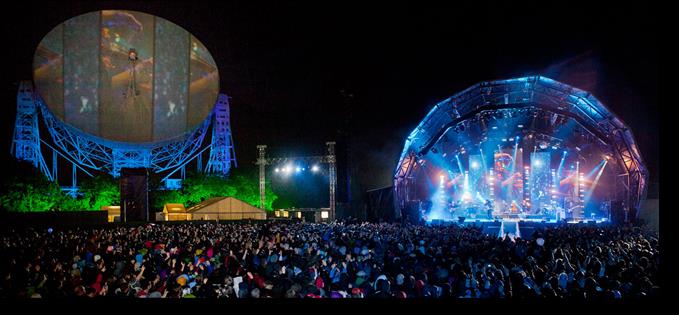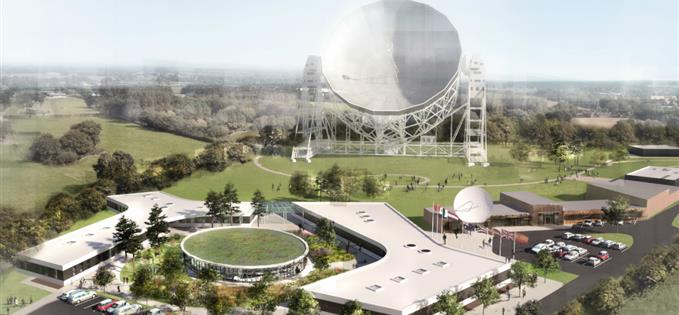THERE is a bit of a myth that the arts and sciences don’t get along. A ‘two cultures’ problem where scientists and artists view one another with suspicion and disdain. Nonsense of course. Artists have always had a fascination with science, and with space in particular. After love, what gets more poetic action than the sun, moon and stars? Pop music in particular, loves the imagery of space exploration (think Bowie in any incarnation) to reflect our inner search for meaning.
They are even keeping half an eye out for extra-terrestrial life
So just imagine a spectacle of lasers, fireworks and thumping electronica, all projected onto the blank white face of a huge telescope. The Bluedot Festival (named after Carl Sagan’s term for Earth as the ‘pale blue dot’) brings together the arts and the sciences for a three-day extravaganza at Jodrell Bank (you can read more about the programme here), proving those cultural naysayers wrong, once and for all.
For most of us, Jodrell Bank probably needs no introduction. It is the scene of many a school trip, backdrop to classic Doctor Who episodes and now ultimate festival venue. But do you remember that back in 2008, Jodrell Bank was under threat of having its funding pulled? At the time the Science and Technology Facilities Council was considering withdrawing its planned £2.7 million annual funding of the e-MERLIN project. Sir Bernard Lovell was quoted as saying "It will be a disaster … The fate of the Jodrell Bank telescope is bound up with the fate of e-MERLIN. I don't think the establishment can survive if the e-MERLIN funding is cut". The e-MERLIN array had only just started to survey the sky so the news of the potential threat came as a huge shock to many.
Several outraged articles, online petitions and even a charity record later, the STFC reversed its decision and the telescope was saved, though it was a close call. Up until this point, the team at Jodrell Bank can well be forgiven for not seeing it coming. Jodrell is, after all, British science history personified in the form of that beautiful white disc.
For those of you a little fuzzy on your British science history, that includes being established in 1945 by Bernard Lovell (whom the telescope is named after), which at the time of completion was the largest telescope in the world (it is now the third largest). It became operational in 1957, just in time to track Sputnik 1, the only telescope in the world able to do so by radar. Then in 1966, the telescope received data from the Luna 9 moon lander. Using fax-like technology borrowed from the Daily Express, the team at Jodrell Bank picked up the signal and managed to process the first picture sent from the surface of another celestial body.
 Elbow perform beneath the Lovell Telescope
Elbow perform beneath the Lovell TelescopeTime-travel back to the present day, and funding fears are over, as the centre has potentially £12m coming its way for the First Light project, which will work on the historic ‘South Side’ of the site – the area in which the key scientific developments took place in the early days of Radio Astronomy. This rosy outlook is in part, thanks to the recent spate of activity which positions Jodrell Bank as an important part of our cultural as well as scientific heritage.
For Bluedot is hardly the Jodrell team’s first foray into popular culture. The Lovell Telescope has been a spectacular backdrop to concerts by the Halle Orchestra, hosted Jodrell Bank Live – featuring The Flaming Lips, Sigur Ros, New Order and many more. Add to that film screenings, art collaborations and outreach programmes such as Girls Night Out to get young women interested in the STEM subjects. Oh and you might have seen a little programme called Stargazing Live, which, in the grand British tradition, takes a solitary pursuit (in this case astronomy, but you could just as easily say baking or pottery) and turns it into cosy yet dramatic telly, beamed to you live from, that’s right, Jodrell Bank.
So, no wonder two of its main movers have been recognised for their work in drawing people into to the world of astrophysics. Dr Teresa Anderson, Director of the Jodrell Bank Discovery Centre, and Professor Tim O’Brien, Associate Director of Jodrell Bank Observatory, were awarded the Kelvin Medal of the Institute of Physics for outstanding contribution to the public understanding of physics in 2014. The centre’s lively approach to engaging with the public is canny to say the least. While the idea of space is sexy, getting to grips with all those neutrinos can be off-putting for those of us without PhDs. Events such as Bluedot are the perfect lure, with just enough science to get the braincells working, but more than enough fun to give them a rest when they feel tired out.
This cultural commotion will not harm Jodrell Bank’s push to be included UNESCO’s list of World Heritage sites (it is currently on the ‘tentative’ list, meaning that UNESCO is considering inclusion). Listed places benefit from extra media attention and increased tourist revenues that the status brings, but it also makes it politically very difficult for a government to harm a site by, say, defunding it. World Heritage Site status would practically gold-plate Jodrell Bank’s status as a living scientific national treasure.
 SKA project at Jodrell Bank
SKA project at Jodrell BankSo the future is not all pop music and Brian Cox – there is some very serious, very heavy scientific research going on at Jodrell Bank right now. All this extra-curricular activity should not detract from the Jodrell Bank Centre for Astrophysics as an important place in the hard sciences. The centre is home to the international headquarters of the Square Kilometre Array, for example. This is a multi-radio telescope (co-sited in Australia and South Africa) that can see deeper into space than any other telescope in the world – ‘the exceptional sensitivity of the SKA will allow observations of the Cosmic Dawn and Epoch of Reionization in unprecedented detail, both spectrally and spatially,’ says the Jodrell Bank website, and who would argue with that? They are even keeping half an eye out for extra-terrestrial life (or astrobiology as they prefer to call it.)
So, fingers crossed, the future is looking, well, damned futuristic for our beloved Lovell Telescope. The directorate probably don’t even need to put on any more music festivals and outreach programmes to feel secure. But when it’s this much fun…














